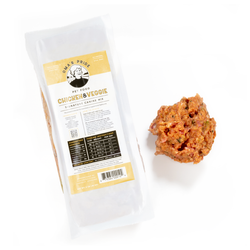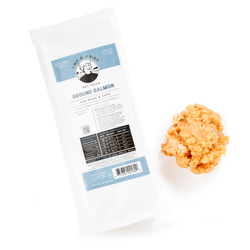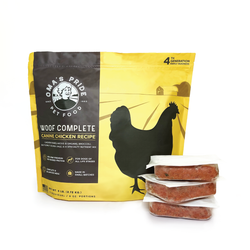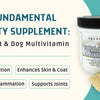The Best Lamb Dog Food: Your Comprehensive Guide
When you think of lamb, what comes to mind? Maybe holiday dinners, lamb chops, or a protein you eat mostly on special occasions.
Lamb has become a more popular meat option in recent years as people have discovered its unique health benefits.
But you may be wondering, "Can dogs eat lamb?"
Yes, dogs can eat lamb! Lamb dog food is an extremely nutritious option for canines because it’s full of beneficial fats to improve energy, reduce allergies, promote relaxation, and support heart health.
Read on to learn where you can buy lamb for your dog online, how lamb compares to beef, and the benefits of lamb for your dog.
Table of contents
- Why is lamb special?
- What type of lamb is best for my dog?
- Where to purchase lamb for dogs
- Main benefits of lamb for dogs
- Lamb versus beef: similarities and differences
What makes lamb special?
Lamb contains more calories per ounce than other proteins commonly found in dog food, such as beef, chicken, turkey, or salmon. Pork and lamb have a similar amount of calories; duck has more calories than lamb.
Lamb is a unique protein option because it’s actually a red meat (like beef). Both beef and lamb are derived from grazing, or ruminant, animals. This means that if your pet has pork or beef sensitivities, lamb is an excellent red meat alternative for them.
Overall, lamb is good for dogs because it is a nutrient-dense protein packed with zinc, iron, vitamin B12, omega-3 and omega-6 fatty acids, folate, selenium, amino acids, and vitamin K2 (menaquinone).

What type of lamb is best for my dog?
Dogs are carnivores; their most biologically appropriate diet is raw dog food with meat, bones, organs, and select vegetables.
If you’re searching for the best source of lamb, try to find grass-fed, pasture-raised, and 100% natural, raw lamb. High-quality lamb contains more bioavailable nutrients, fewer toxins, and fewer bacteria than low-quality meat.
Tip! Consider avoiding “lamb meal,” typically found in kibble. Lamb meal is highly processed and rendered from animal tissue, bones, and organs. The cooking process removes moisture and often hides low-quality ingredients.
Overall, lamb meal is more inflammatory and difficult for canines to digest properly; on the other hand, investing in premium raw lamb can provide numerous health benefits for your dog.
Where to purchase lamb dog food online
You can purchase high-quality dog food with lamb directly from Oma’s Pride.
Oma’s Pride lamb is:
- Raised & sourced in the USA, New Zealand, or Australia
- Made from grass-fed, antibiotic-free, and hormone-free lamb
- 100% raw (no HPP)
- All-natural without additives, flavorings, by-products, artificial colors, or chemicals
- Available both dehydrated and frozen raw
1. Lamb Lung
Lamb toppers and chews are a great option for pet parents searching for a healthy treat or nutritious meal booster. Dehydrated treats are convenient and allow you to incorporate the benefits of raw lamb into your dog’s cooked or kibble diet.
Purchase dehydrated Lamb Lung in 2 oz or 8 oz. Lamb Lung is extremely popular, suitable for cats and dogs, and is low odor. Get all the benefits of raw lamb in a travel-safe and convenient form.
Adding any raw, whole foods to your dog’s (or cat’s) diet is better than no raw at all!
2. Frozen raw lamb meals
Option 1: If you’re looking for an all-in-one lamb meal for your dog, purchase Woof Complete Lamb Recipe with lamb meat, bones, organs, select veggies, & a special nutrient mix. You don’t need to add anything to this meal—it meets and exceeds AAFCO standards for all life stages.
Option 2: Purchase the Lamb & Veggie Signature Mix. These mixes are intended for supplemental feeding and contain lamb meat, bones, hearts, and select vegetables.
Explore Products
6 top benefits of lamb for dogs
So, is lamb good for dogs? Yes! Lamb is the perfect protein option for many dogs, including active dogs, anxious dogs, those with allergies, or pups on a rotational diet.
Lamb is rich in key nutrients like tryptophan, vitamin K2, fatty acids, iron, vitamin B12, and folate to promote circulation, inhibit histamine production, boost energy levels, and more.

1. Perfect for active dogs
Lamb contains more calories and healthy fats per ounce than many other proteins. If you have a very active or working dog, lamb meat can help you meet their daily caloric requirements.
Also, high levels of niacin found in lamb help convert food into energy production and boost metabolism. This allows your active dog to optimize their energy utilization throughout the day.
2. Great for allergies or sensitivities
If you have a picky, sensitive, or allergy-prone dog, lamb is a perfect choice for them.
Why? Lamb's gamey, earthy flavor profile attracts most dogs—even picky eaters. Lamb is also rich in vitamin K2 (also called menaquinone), which inhibits histamine production.
Additionally, dogs have far fewer food allergies to lamb compared to other common dog food ingredients:
“The most frequently reported food allergens involved in CAFRs [cutaneous adverse food reactions] in dogs were beef (102 dogs, 34%), dairy products (51 dogs, 17%), chicken (45 dogs, 15%), wheat (38 dogs, 13%) and lamb (14, 5%)” (source).
3. Ideal for rotational feeding
If you practice supplemental or rotational feeding, consider adding lamb into the mix.
Lamb has a unique amino acid profile compared to other popular proteins. Rotating foods can reduce food intolerances and expose your pet to a variety of vitamins, aminos, and minerals over time. It can also boost immunity by keeping the system adaptable.
4. Rich in fatty acids
Lamb is extremely rich in omega-3 and omega-6 fatty acids (good fats). These fatty acids reduce inflammation and blood pressure, boost energy and metabolism, repair muscular and skeletal tissue, and improve cognitive function.
Increasing fatty acids in your dog’s diet can also make their coat and skin shiny and healthy.


5. Naturally calming
Tryptophan, an amino acid, is a calming agent. Lamb contains even more tryptophan per gram than turkey, making it a perfect protein to help your pup relax, sleep, stay calm, and reduce anxiety.
6. Supports blood health and circulation
Concerned about your dog’s blood health and circulation? The iron, folate, and vitamin B12 in lamb make it a superfood for blood health and circulation.
Folate plays a huge role in red blood cell formation and cell growth. Iron helps produce hemoglobin to transport oxygen to all parts of the body. Vitamin K2 supports healthy blood clotting and calcium removal within the arteries.
Finally, as dogs age, they may begin to have more trouble with circulation. Adding lamb to a senior dog’s bowl can help them get their blood pumping to stay mobile.
Lamb versus beef for dogs: similarities & differences
Since lamb is a red meat like beef, many pet parents want to know: which is healthier? At the end of the day, both lamb and beef are great protein options for most dogs. However, they have different protein, vitamin, and mineral levels.
Some pet parents choose to rotate between the proteins, while others may decide one is better for their dog. Here is a chart to help you decide!
| Lamb (Per Ounce) | Beef (Per Ounce) | |
|---|---|---|
| Protein | 7 grams | 8 grams |
| Calories | 81 calories | 73 calories |
| Price | On average, lamb is less expensive than beef. (However, Oma’s Pride lamb is more expensive than beef.) | On average, beef is more expensive than lamb. (However, Oma’s Pride beef is less expensive.) |
| Fatty acids | 2.7 grams | 2 grams |
| Allergic Reactions | 5% | 34% |
| Selenium | 11% of the daily value | 9% of the daily value |
| Zinc | 9% of the daily value | 12% of the daily value |
| Niacin | 10% of the daily value | 8% of the daily value |
| Vitamin B12 | 12% of the daily value | 13% of the daily value |
| Iron | 3% of the daily value | 6% of the daily value |
Final thoughts
If your dog has never tried lamb, consider treating them to a dehydrated treat or feeding them high-quality lamb dog food with meat, bones, organs, and vegetables. This protein is ideal for active dogs needing calories, dogs with allergies, and anxious dogs.
Lamb is higher in calories, fatty acids, selenium, and niacin than beef. Beef is higher in protein, zinc, vitamin B12, and iron. On average, beef is more expensive per pound; lamb induces fewer allergic reactions.
Leave a comment
Your email address will not be published. Required fields are marked with *






















